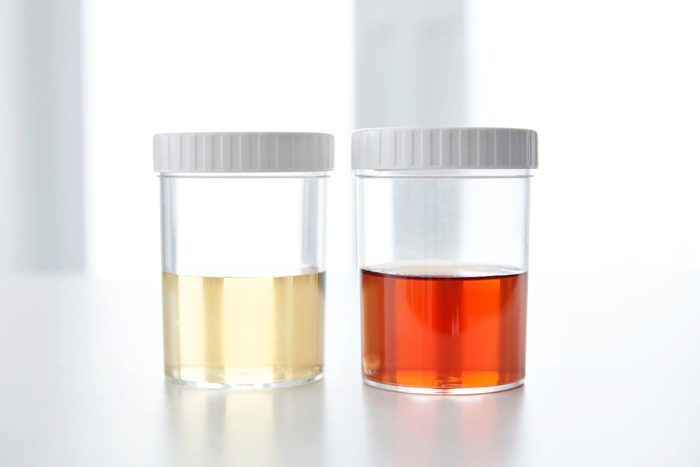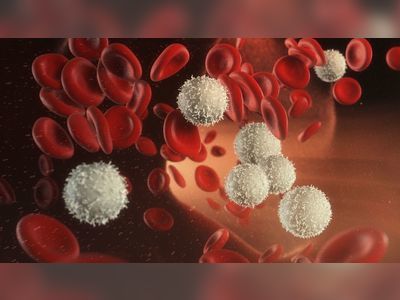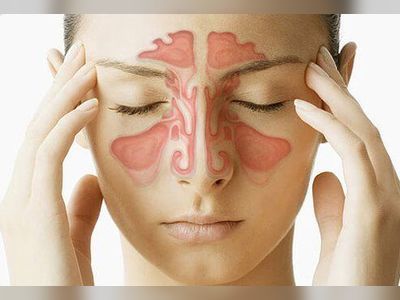
This Urine Colour Chart Reveals Exactly What Your Pee Colour Means
Your urine colour can sometimes be a surprise, whether it's bright yellow or even red or violet. Here's what you need to know about pee colour, including what's normal and what's not.
The colour of your pee can tell you a lot about your overall health-if you know what you are looking at and for. The shades of urine are as diverse as the colours in a rainbow. And urine can change colours for many different reasons. Some factors include the food you eat, the amount of water you drink, the medicines or vitamins you take, certain medical conditions, or how often and hard you hit the gym, according to Marisa Clifton, MD, an assistant professor of urology and the director of women’s health at the Brady Urological Institute at Johns Hopkins Medicine in Baltimore, Maryland.
So, what colour should pee be? Here’s what experts want you to know. Plus, a urine colour chart to help you understand what your pee colour means.
What colour should urine or pee be?
Yellowish, Dr. Clifton says. Yellow is the colour we normally associate with urine, but there are shades of yellow. “If it’s dark yellow, brown, or even orange, you can be very dehydrated, while crystal clear to no colour suggests that you are adequately hydrated,” she says.
Bright yellow or fluorescent urine is usually from overdoing vitamin B complex foods or supplements, specifically B2 or riboflavin and/or multivitamins, including prenatal vitamins. This is harmless, Dr. Clifton says. You might be taking more than you need, and the excess is most likely mixing with your urine as it exits the body.
Why is my pee clear?
Clear urine actually refers to urine without any cells, debris, particles, or cloudiness. This is a good thing. However, many people refer to urine without a strong colour as “clear,” when the actual word they mean is colourless or diluted. Nevertheless, the more water you drink, the less colour your urine has. Occasionally colourless or light-coloured urine isn’t an issue, especially if you’re temporarily drinking more water than normal.
If your urine is consistently clear, absent of colour, diluted, and occurs frequently, it could signify a health issue like kidney problems, diabetes, or overhydration.
Why do I have white pee?
People wondering about white pee or urine are usually referring to cloudy or milky urine. Aside from dehydration, there are a few possible causes. One potential cause is urinary tract infections or UTIs, according to The Journal of Spinal Cord Medicine. UTIs can cause cloudy urine and an unpleasant odor.
And people with diabetes are at a higher risk of UTIs because their high glucose levels make it tougher to fight the infection, according to a review in Diabetes, Metabolic Syndrome and Obesity: Targets and Therapy.
Another cause of white pee or urine are kidney stones, according to the National Kidney Foundation.
Urine colour chart
Why is my urine red?
If you see red when you pee, it’s tempting to hit the panic button. But it isn’t always a sign that something is really wrong. Have you eaten beets, blackberries, or rhubarb lately? If so, these may be the cause of your red or pinkish urine, Dr. Clifton says. Certain medications, including phenazopyridine (Pyridium), a drug that numbs urinary tract discomfort, and over-the-counter laxatives that contain senna can turn your urine reddish-orange, she says. The same holds for Rifampin, an antibiotic used to treat tuberculosis. Is it blood? It could be, she says. The medical name for blood in the urine is hematuria.
Other reasons for red or red-tinged urine may include blood from UTIs, she says. However, blood in the urine is usually not the only symptom of a UTI. “Infections have other signs, including burning when urinating, urgency, and/or fevers,” she says.
Kidney stones are another cause of blood in your urine, Dr. Clifton continues. “If it is a kidney stone, you may feel pain on one side versus another, and it can be very severe pain,” she says.
Bladder stones may also cause you to have blood in your urine. These are small, hard crystals that form in your urine and can become trapped in your bladder. For men, blood in the urine may be a sign of prostatitis, a prostate inflammation that can be caused by infections. It’s the most common urinary tract problem in men under age 50 and the third most common after age 50.
Another possibility is benign prostatic hyperplasia (BPH), which is an enlarged prostate that occurs in almost all men as they age. An enlarged prostate may press on the urethra, the tube that carries urine out of your bladder, causing bladder irritation and bleeding. “Symptoms can be more important than colour, so make sure to tell your doctor if you are experiencing any pain, urgency, or burning,” adds Elizabeth Kavaler, MD, a urologist at Lenox Hill Hospital in New York City.
Blood in the urine can also be a sign of kidney disease or infections; trauma (such as a fall or car accident that caused damage to the urinary tract); inherited diseases like sickle cell anemia; medications like penicillin or the chemotherapy drug cyclophosphamide; or bladder, kidney, or prostate cancer.
Many of these conditions or problems are less common than other issues and usually have other symptoms as well, so see your doctor to have it checked out.
What about dark red urine?
It doesn’t have to be bright red blood either. “Darker coloured red may be old blood that has been in the urinary tract a little bit longer,” Dr. Clifton says.
Your urine may also turn dark brown if you eat a large portion of fava beans, rhubarb, or aloe, she says. Some medications, including antimalarial drugs and some antibiotics, can cause cola-coloured urine.
Sometimes extreme exercise can cause cola-coloured urine, too, because it triggers the breakdown of muscles known as rhabdomyolysis. This condition, sometimes shortened to rhabdo, can also be caused by crush or traumatic injuries; drug use, such as cocaine or methamphetamines; heat exposure; or taking supplements like creatine or ephedra. When this happens, myoglobin releases and excretes into your urine, Dr. Clifton explains. This can damage your heart or kidneys and the condition can be potentially life threatening.
What to do about red urine?
“When you have bleeding in urine and are not certain why, see a doctor who can do an analysis of the urine and guide you to see a specialist,” she says. Don’t panic, she says. “There are times it is nothing and goes away on its own.”
Also, you may want to double-check the source of the blood. Are you sure it is really coming from your urethra? “If women see blood when they wipe, it can be from the urethra or the vagina, so it’s important to also consider a gynecological exam, too,” Dr. Clifton says.
Why is my urine orange?
As you may recall from art class in elementary school, red plus yellow makes orange. If your urine has an orangey hue, it could be blood, according to Dr. Clifton. “If urine is dark and orange, especially if you have pale stools or yellow skin and eyes, it could be a sign of a liver issue,” Dr. Clifton says. This should be evaluated, she notes.
She says that the anti-inflammatory drug sulfasalazine (Azulfidine), phenazopyridine, some laxatives, and certain chemotherapy drugs might also cause urine to be orange.
Why is my pee green and blue?
Yes, your urine can be green or blue, Dr. Clifton says. “The antidepressant amitriptyline, the pain reliever indomethacin (Indocin, Tivorbex), and the anesthetic propofol (Diprivan) may turn your urine blue or green,” she says.
Certain bacteria, namely pseudomonas, can turn urine a greenish colour, Dr. Kavaler adds. Asparagus sometimes gives urine a greenish hue too. Eating asparagus is also one of the reasons your pee smells funny.
Additionally, inherited medical conditions cause blue or green urine, including, “blue diaper syndrome,” also known as Drummond’s Syndrome or familial hypercalcemia. This is rare and occurs when the body can’t break down the amino acid tryptophan.
Purple, indigo, or violet urine can occur if you have a bacterial infection, Dr. Clifton explains. For example, “purple urine bag syndrome” occurs when urinary catheters and bags become purple due to a bacterial infection, and as a result, so too does urine, Dr. Clifton explains.
What about foamy urine or urine with bubbles?
If you consistently have layers of small or medium bubbles in your urine, it could be proteinuria, or excess protein in your urine. This can be a sign of kidney disease. However, only about one in three people with foamy urine actually have excess protein. That means that in two out of three people, foamy urine has an unknown cause and isn’t due to kidney disease. See a doctor to be sure.
What’s more, if you have single layer of relatively large bubbles when you pee that quickly dissipates, that’s considered normal and nothing to be concerned about.
Further testing
Several tests can help find out why your urine is red or another not-quite-so-typical shade, she says. The fastest way to see what’s up is a rapid urine test. After you pee in a cup, your doctor dips a test strip into the sample. The fields on the strip change colour based on what is found. This test can identify acidity levels, protein in your urine, blood sugar or glucose, nitrites that suggest a UTI, ketones, which occur when your body starts breaking down fat for fuel, red or white blood cells, and or bilirubin that could indicate liver issues.
“This isn’t as specific as sending a sample to the lab for evaluation under a microscope,” Dr. Clifton says. Urinalysis is a follow-up when there are abnormal results from a rapid urine test. It involves looking at the urine under a microscope to look for bacteria, check kidney function, or test for diabetes, according to the Institute for Quality and Efficiency in Health Care.
If bacteria are found in urine, a urine culture can determine what type, and guide treatment. A 24-hour urine collection collects a full day’s worth of urine. The result of this test can detect amounts of proteins, hormones, and other substances in urine.
Sometimes blood tests or other imaging exams are necessary to find out what’s going on, Dr. Clifton says.
Last word
The colour of your urine can reveal important information about your health. “It’s not a bad idea to look in the toilet or check the toilet paper intermittently, but you don’t have to turn on the light every night to make sure it’s OK,” Dr. Clifton says.
And seeing isn’t always believing, Dr. Kavaler adds. “Colour can be affected by the colour of the toilet and lighting,” she says. It’s always better to be safe than sorry, so if you are at all concerned about the colour of your urine, check in with your doctor, she adds.











